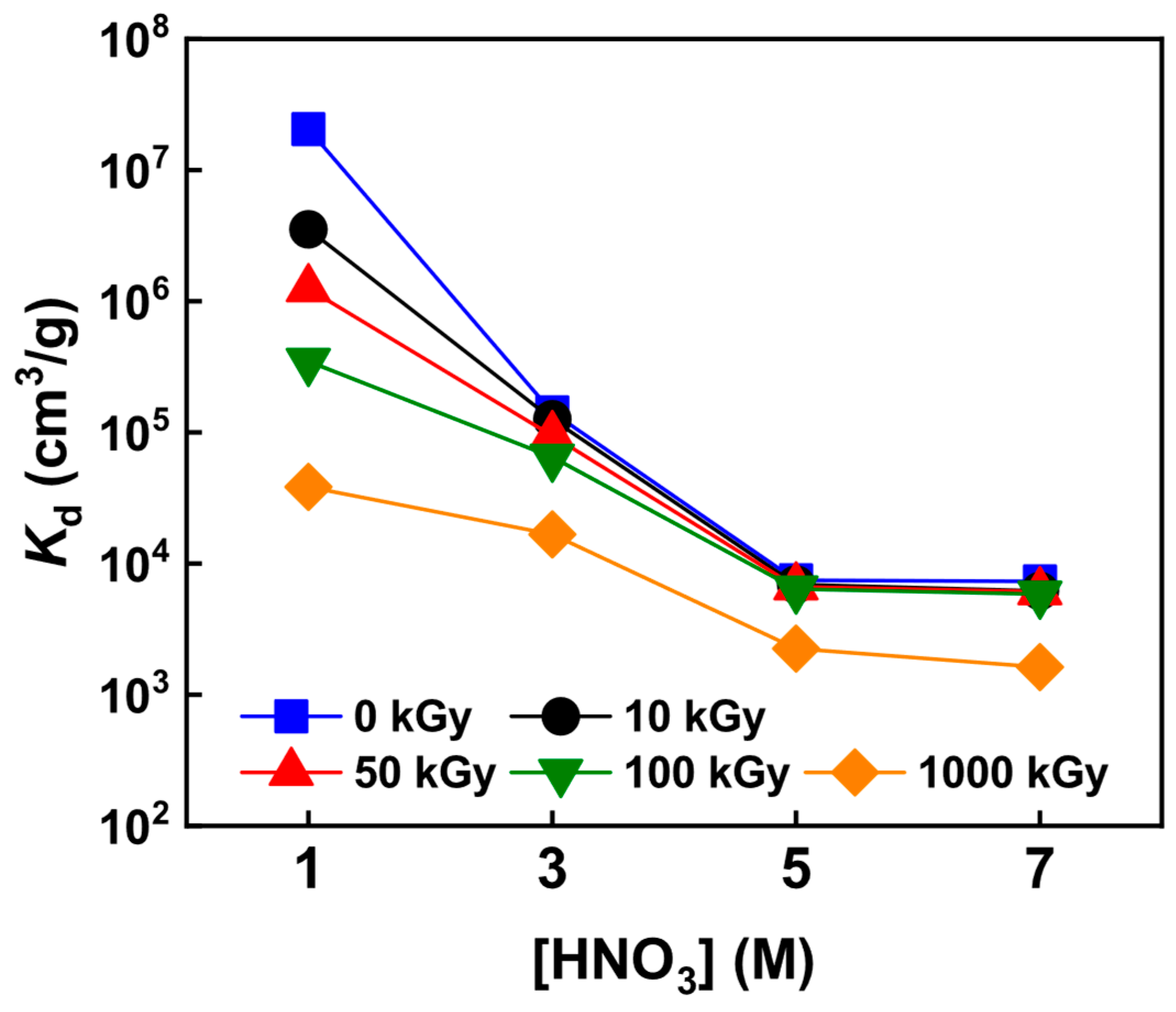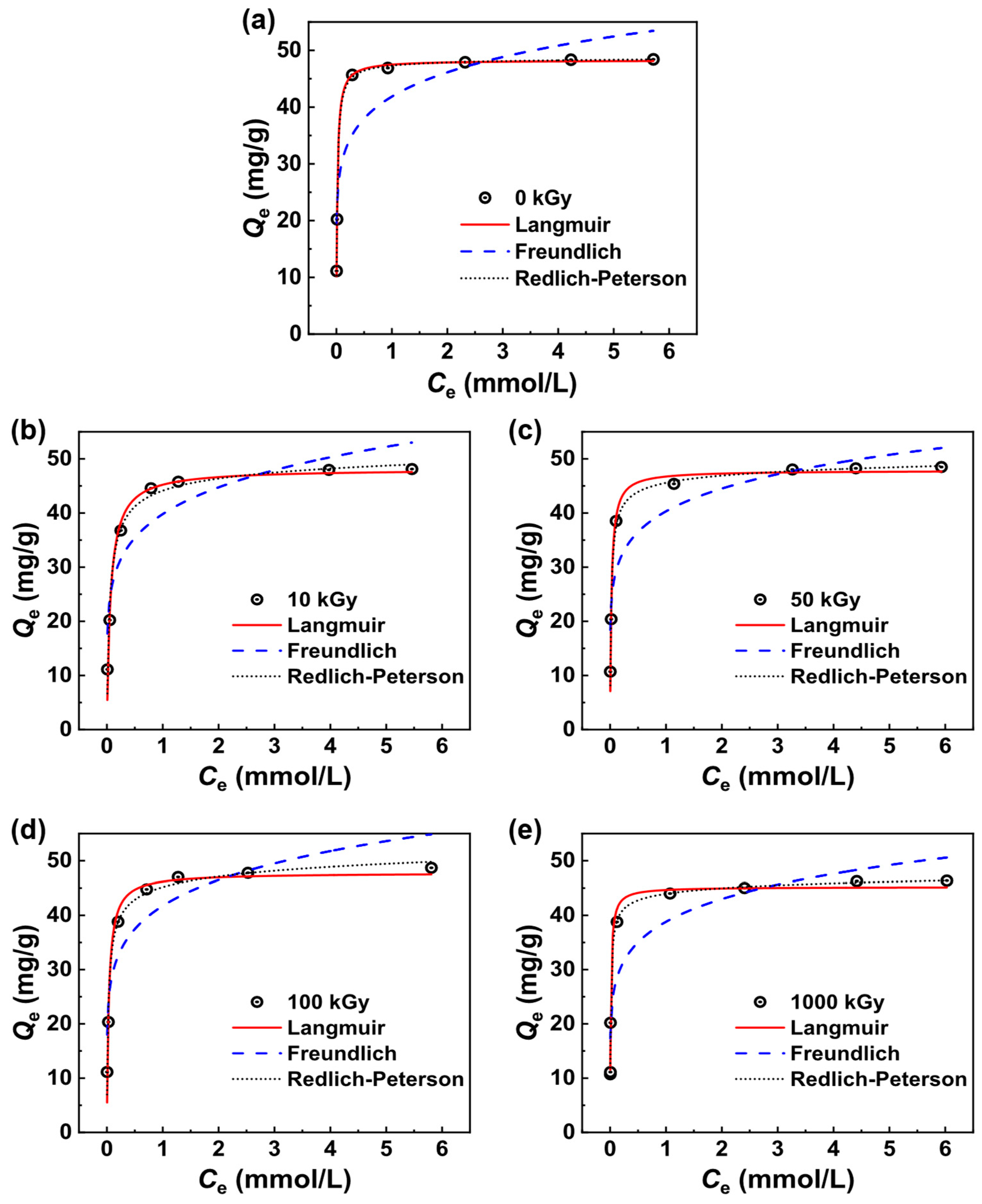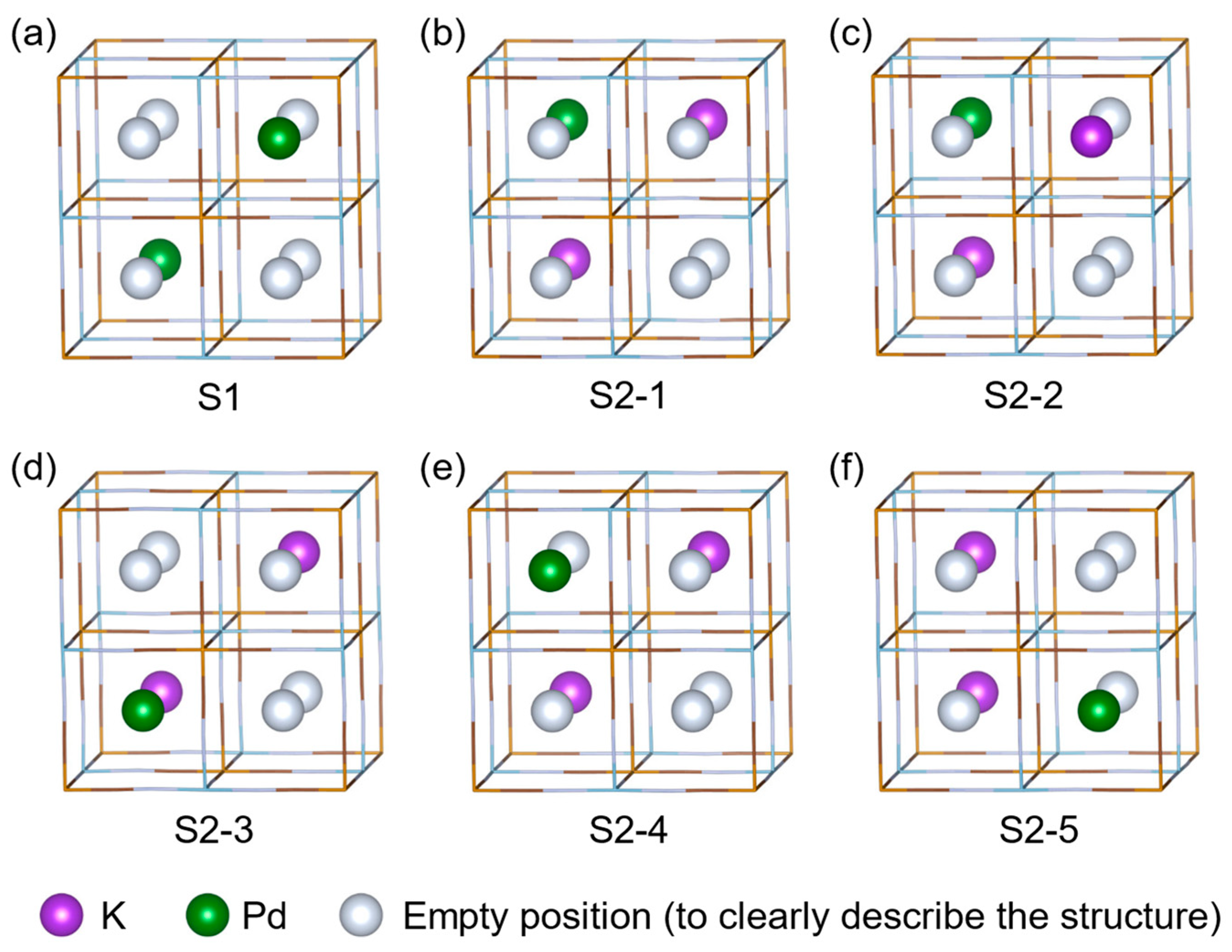Radiation Resistance and Adsorption Behavior of Aluminum Hexacyanoferrate for Pd
Abstract
1. Introduction
2. Materials and Methods
2.1. Materials
2.2. Preparation of KAlFe(CN)6/SiO2
2.3. Irradiation Treatment and Characterization
2.4. Batch Experiments
2.5. DFT Calculations
3. Results and Discussion
3.1. XRD Analysis before and after Irradiation
3.2. SEM and FT–IR Analysis before and after Irradiation
3.3. Adsorption Properties in Nitric Acid before and after Irradiation
3.4. Adsorption Isotherms before and after Irradiation
3.5. DFT Calculations
4. Conclusions
Author Contributions
Funding
Institutional Review Board Statement
Informed Consent Statement
Data Availability Statement
Conflicts of Interest
References
- IAEA. Climate Change and Nuclear Power 2018; International Atomic Energy Agency: Vienna, Austria, 2018. [Google Scholar]
- Kharecha, P.A.; Hansen, J.E. Prevented Mortality and Greenhouse Gas Emissions from Historical and Projected Nuclear Power. Environ. Sci. Technol. 2013, 47, 4889–4895. [Google Scholar] [CrossRef] [PubMed]
- Zou, S.; Kuang, Y.; Tang, D.; Guo, Z.; Xu, S. Risk analysis of high level radioactive waste storage tank based on HAZOP. Ann. Nucl. Energy 2018, 119, 106–116. [Google Scholar] [CrossRef]
- Wu, Y.; Lee, C.-P.; Mimura, H.; Zhang, X.; Wei, Y. Stable solidification of silica-based ammonium molybdophosphate by allophane: Application to treatment of radioactive cesium in secondary solid wastes generated from fukushima. J. Hazard. Mater. 2018, 341, 46–54. [Google Scholar] [CrossRef] [PubMed]
- Wu, Y.; Zhang, X.-X.; Wei, Y.-Z.; Mimura, H. Development of adsorption and solidification process for decontamination of Cs-contaminated radioactive water in Fukushima through silica-based AMP hybrid adsorbent. Sep. Purif. Technol. 2017, 181, 76–84. [Google Scholar] [CrossRef]
- Laurin, C.; Régnier, E.; Gossé, S.; Laplace, A.; Agullo, J.; Mure, S.; Brackx, E.; Toplis, M.; Pinet, O. Redox behavior of ruthenium in nuclear glass melt: Ruthenium dioxide reduction reaction. J. Nucl. Mater. 2021, 545, 152650. [Google Scholar] [CrossRef]
- Wei, Y.; Wu, Y.; Li, H. The Newest Nuclear Fuel Cycle; Shanghai Jiao Tong University Press: Shanghai, China, 2016; pp. 99–125, 225–268, 313–360. [Google Scholar]
- Hassan, I.A.; Saleh, H.M. Biological Effects of Hazardous Waste: Threshold Limits of Anomalies and Protective Approaches. Hazard. Waste Manag. Health Risks 2020, 1, 62. [Google Scholar] [CrossRef]
- Choppin, G.; Liljenzin, J.-O.; Rydberg, J.; Ekberg, C. Chapter 15—Radiation Biology and Radiation Protection. In Radiochemistry and Nuclear Chemistry, 4th ed.; Choppin, G., Liljenzin, J.-O., Rydberg, J., Ekberg, C., Eds.; Academic Press: Cambridge, MA, USA, 2013; pp. 445–491. [Google Scholar]
- Abdelhamid, A.A.; Badr, M.H.; Mohamed, R.A.; Saleh, H.M. Using Agricultural Mixed Waste as a Sustainable Technique for Removing Stable Isotopes and Radioisotopes from the Aquatic Environment. Sustainability 2023, 15, 1600. [Google Scholar] [CrossRef]
- Dawoud, M.M.A.; Hegazi, M.M.; Saleh, H.M.; El Helew, W.K. Removal of stable and radio isotopes from wastewater by using modified microcrystalline cellulose based on Taguchi L16. Int. J. Environ. Sci. Technol. 2023, 20, 1289–1300. [Google Scholar] [CrossRef]
- Forsberg, C.W. Rethinking High-Level Waste Disposal: Separate Disposal of High-Heat Radionuclides (90Sr and 137Cs). Nucl. Technol. 2000, 131, 252–268. [Google Scholar] [CrossRef]
- Sawai, M. Rokkasho Reprocessing Plant: Vitrification Problems Continue Nuke Info Tokyo No. 125. Available online: https://cnic.jp/english/?p=1233 (accessed on 19 October 2022).
- Wang, Q.; Sang, H.; Chen, L.; Wu, Y.; Wei, Y. Selective separation of Pd(II) through ion exchange and oxidation-reduction with hexacyanoferrates from high-level liquid waste. Sep. Purif. Technol. 2020, 231, 115932. [Google Scholar] [CrossRef]
- Xu, K. International research progress on nuclear waste vitrification: A review. Mater. China 2016, 35, 481–488+517. [Google Scholar] [CrossRef]
- Lu, J.; Lin, P.; Li, L.; Zhao, X.; Wang, Y.; Weng, H.; Lin, M. Solubility of typical PGMs in HLLW glass and influence of PGMs on the properties of HLLW glass. Radiat. Prot. 2023, 43, 17–30. [Google Scholar]
- Yadav, M.; Misra, A.; Malhotra, A.; Kumar, N. Design and analysis of a high-pressure turbine blade in a jet engine using advanced materials. Mater. Today Proc. 2020, 25, 639–645. [Google Scholar] [CrossRef]
- Yakoumis, I. PROMETHEUS: A Copper-Based Polymetallic Catalyst for Automotive Applications. Part I: Synthesis and Characterization. Materials 2021, 14, 622. [Google Scholar] [CrossRef]
- Holdsworth, A.F.; Eccles, H.; Sharrad, C.A.; George, K. Spent Nuclear Fuel—Waste or Resource? The Potential of Strategic Materials Recovery during Recycle for Sustainability and Advanced Waste Management. Waste 2023, 1, 249–263. [Google Scholar] [CrossRef]
- Venkatesan, K.A.; Selvan, B.R.; Antony, M.P.; Srinivasan, T.G.; Rao, P.R.V. Extraction of palladium from nitric acid medium by commercial resins with phosphinic acid, methylene thiol and isothiouronium moieties attached to polystyrene-divinylbenzene. J. Radioanal. Nucl. Chem. 2005, 266, 431–440. [Google Scholar] [CrossRef]
- Suzuki, T.; Otsubo, U.; Ogata, T.; Shiwaku, H.; Kobayashi, T.; Yaita, T.; Matsuoka, M.; Murayama, N.; Narita, H. Selective adsorption of Pd(II) over Ag(I) in nitric acid solutions using nitrogen-donor-type adsorbents. Sep. Purif. Technol. 2023, 308, 122943. [Google Scholar] [CrossRef]
- Peng, L.; Zhang, M.; Dong, Z.; Qi, W.; Zhai, M.; Zhao, L. Efficient and selective adsorption of Pd(II) by amino acid-functionalized cellulose microspheres and their applications in palladium recovery from PCBs leaching solution. Sep. Purif. Technol. 2022, 301, 122037. [Google Scholar] [CrossRef]
- Zhou, L.; Xu, J.; Liang, X.; Liu, Z. Adsorption of platinum(IV) and palladium(II) from aqueous solution by magnetic cross-linking chitosan nanoparticles modified with ethylenediamine. J. Hazard. Mater. 2010, 182, 518–524. [Google Scholar] [CrossRef]
- Els, E.R.; Lorenzen, L.; Aldrich, C. The adsorption of precious metals and base metals on a quaternary ammonium group ion exchange resin. Miner. Eng. 2000, 13, 401–414. [Google Scholar] [CrossRef]
- Ma, H.-W.; Liao, X.-P.; Liu, X.; Shi, B. Recovery of platinum(IV) and palladium(II) by bayberry tannin immobilized collagen fiber membrane from water solution. J. Membr. Sci. 2006, 278, 373–380. [Google Scholar] [CrossRef]
- Awual, M.R.; Khaleque, M.A.; Ratna, Y.; Znad, H. Simultaneous ultra-trace palladium(II) detection and recovery from wastewater using new class meso-adsorbent. J. Ind. Eng. Chem. 2015, 21, 405–413. [Google Scholar] [CrossRef]
- Tang, Y.; Li, W.; Feng, P.; Zhou, M.; Wang, K.; Jiang, K. Investigation of alkali-ion (Li, Na and K) intercalation in manganese hexacyanoferrate KxMnFe(CN)6 as cathode material. Chem. Eng. J. 2020, 396, 125269. [Google Scholar] [CrossRef]
- Hamoud, M.A.; Allan, K.F.; Sanad, W.A.; Saad, E.A.; Mahmoud, M.R. Synthesis of PAN/ferrocyanide composite incorporated with cetrimonium bromide and its employment as a bifunctional adsorbent for coremoval of Cs+ and HCrO4− from aqueous solutions. J. Radioanal. Nucl. Chem. 2020, 324, 647–661. [Google Scholar] [CrossRef]
- Nilchi, A.; Saberi, R.; Moradi, M.; Azizpour, H.; Zarghami, R. Adsorption of cesium on copper hexacyanoferrate–PAN composite ion exchanger from aqueous solution. Chem. Eng. J. 2011, 172, 572–580. [Google Scholar] [CrossRef]
- Holdsworth, A.F.; Eccles, H.; Rowbotham, D.; Brookfield, A.; Collison, D.; Bond, G.; Kavi, P.C.; Edge, R. The Effect of Gamma Irradiation on the Physiochemical Properties of Caesium-Selective Ammonium Phosphomolybdate–Polyacrylonitrile (AMP–PAN) Composites. Clean Technol. 2019, 1, 294–310. [Google Scholar] [CrossRef]
- Holdsworth, A.F.; Eccles, H.; Rowbotham, D.; Bond, G.; Kavi, P.C.; Edge, R. The Effect of Gamma Irradiation on the Ion Exchange Properties of Caesium-Selective Ammonium Phosphomolybdate-Polyacrylonitrile (AMP-PAN) Composites under Spent Fuel Recycling Conditions. Separations 2019, 6, 23. [Google Scholar] [CrossRef]
- Tranter, T.J.; Herbst, R.S.; Todd, T.A.; Olson, A.L.; Eldredge, H.B. Evaluation of ammonium molybdophosphate-polyacrylonitrile (AMP-PAN) as a cesium selective sorbent for the removal of 137Cs from acidic nuclear waste solutions. Adv. Environ. Res. 2002, 6, 107–121. [Google Scholar] [CrossRef]
- Momma, K.; Izumi, F. VESTA 3 for three-dimensional visualization of crystal, volumetric and morphology data. J. Appl. Crystallogr. 2011, 44, 1272–1276. [Google Scholar] [CrossRef]
- Perdew, J.P.; Burke, K.; Ernzerhof, M. Generalized Gradient Approximation Made Simple. Phys. Rev. Lett. 1996, 77, 3865–3868. [Google Scholar] [CrossRef]
- Mao, J.; Wang, T.; Zhang, X.; Sun, M.; Wang, T.; Peng, H. Equivalence analysis of electron and γ-ray irradiation effects on borosilicate glass. Mod. Appl. Phys. 2021, 12, 116–122. [Google Scholar]
- Was, G.S. Fundamentals of Radiation Materials Science; Springer: New York, NY, USA, 2017; pp. 167–181. [Google Scholar]
- Jing, T. Study on radiation damage of electron and γ-rays and mechanism of nuclear hardening. China Nucl. Sci. Technol. Rep. 2000, 00, 1284–1294. [Google Scholar]
- Nakamoto, K. Infrared and Raman Spectra of Inorganic and Coordination Compounds, 4th ed.; Chemical Industry Press: Beijing, China, 1991. [Google Scholar]
- Roque-Malherbe, R.; Carballo, E.; Polanco, R.; Lugo, F.; Lozano, C. Structure and adsorption properties of a porous cooper hexacyanoferrate polymorph. J. Phys. Chem. Solids 2015, 86, 65–73. [Google Scholar] [CrossRef]
- Nishioka, H.; Nishikawa, M.; Katagi, M.; Tatsuno, M.; Tsuchihashi, H. Analysis of Cyanide Compounds Using Fourier Transform Raman Spectroscopy. Jpn. J. Sci. Technol. Identif. 2000, 4, 61–66. [Google Scholar] [CrossRef]
- Hu, Y.; Hu, H.; Yang, M.; Huang, H.; Feng, H. Radiolysis of copper cyanide solution by electron-beam irradiation. Environ. Pollut. Prev. 2009, 31, 31–34. [Google Scholar]
- Liu, Y.; Hu, H.; Yang, M.; Liu, J.; Dang, J.; Wu, Y. Study on the degradation of zinc-cynide complex in gold-leaching wastewater by the E-beam radiolysis. Ind. Saf. Environ. Prot. 2011, 37, 4–6. [Google Scholar]
- Ho, Y.S.; McKay, G. Pseudo-second order model for sorption processes. Process Biochem. 1999, 34, 451–465. [Google Scholar] [CrossRef]
- Langmuir, I. The constitution and fundamental properties of solids and liquids. Part I. Solids. J. Am. Chem. Soc. 1916, 38, 2221–2295. [Google Scholar] [CrossRef]
- Laskar, I.I.; Hashisho, Z. Insights into modeling adsorption equilibria of single and multicomponent systems of organic and water vapors. Sep. Purif. Technol. 2020, 241, 116681. [Google Scholar] [CrossRef]
- Redlich, O.; Peterson, D.L. A Useful Adsorption Isotherm. J. Phys. Chem. 1959, 63, 1024. [Google Scholar] [CrossRef]
- Muslu, N.; Gülfen, M. Selective separation and concentration of Pd(II) from Fe(III), Co(II), Ni(II), and Cu(II) ions using thiourea-formaldehyde resin. J. Appl. Polym. Sci. 2011, 120, 3316–3324. [Google Scholar] [CrossRef]
- Zhao, J.; Wang, C.; Wang, S.; Zhang, L.; Zhang, B. Augmenting the adsorption parameters of palladium onto pyromellitic acid-functionalized nanosilicas from aqueous solution. Colloids Surf. A Physicochem. Eng. Asp. 2019, 578, 123581. [Google Scholar] [CrossRef]
- Kasaini, H.; Goto, M.; Furusaki, S. Selective Separation of Pd(II), Rh(III), and Ru(III) Ions from a Mixed Chloride Solution Using Activated Carbon Pellets. Sep. Sci. Technol. 2000, 35, 1307–1327. [Google Scholar] [CrossRef]
- Xu, L.; Zhang, A.; Pu, N.; Xu, C.; Chen, J. Development of Two novel silica based symmetric triazine-ring opening N-donor ligands functional adsorbents for highly efficient separation of palladium from HNO3 solution. J. Hazard. Mater. 2019, 376, 188–199. [Google Scholar] [CrossRef]
- Togo, A.; Tanaka, I. First principles phonon calculations in materials science. Scr. Mater. 2015, 108, 1–5. [Google Scholar] [CrossRef]
- Wang, V.; Xu, N.; Liu, J.-C.; Tang, G.; Geng, W.-T. VASPKIT: A user-friendly interface facilitating high-throughput computing and analysis using VASP code. Comput. Phys. Commun. 2021, 267, 108033. [Google Scholar] [CrossRef]








| Irradiation Dose (kGy) | Angle of Incidence 2θ (°) | Lattice Parameters a = b = c (Å) | ||
|---|---|---|---|---|
| Peak 1 | Peak 2 | Peak 3 | ||
| 0 | 17.672 | 25.028 | 36.051 | 10.0155 |
| 10 | 17.661 | 24.997 | 35.923 | 10.0246 |
| 50 | 17.642 | 24.958 | 35.884 | 10.0268 |
| 100 | 17.582 | 24.938 | 35.765 | 10.0323 |
| 1000 | 17.482 | 24.840 | 35.746 | 10.0464 |
| Adsorption Kinetic Models | Parameters | |||
|---|---|---|---|---|
| 0 kGy | 50 kGy | 1000 kGy | ||
| Pseudo-first-order kinetic model | k1 (10−3 mg g−1 min−1) | 54.51 ± 5.06 | 35.26 ± 5.73 | 32.99 ± 7.34 |
| Qe (mg g−1) | 6.158 ± 1.29 | 5.015 ± 1.34 | 5.001 ± 1.46 | |
| R2 | 0.9427 | 0.8405 | 0.8038 | |
| Pseudo-second-order kinetic model | k2 (10−3 mg g−1 min−1) | 25.36 ± 1.71 | 24.83 ± 1.83 | 17.48 ± 2.87 |
| Qe (mg g−1) | 20.95 ± 0.12 | 20.82 ± 0.10 | 20.61 ± 0.19 | |
| R2 | 0.9998 | 0.9999 | 0.9994 | |
| Experimental data | Q (mg/g) | 20.60 ± 0.8 | 20.48 ± 0.8 | 20.45 ± 0.8 |
| Isotherm Models | Parameters | Irradiation Dose (kGy) | ||||
|---|---|---|---|---|---|---|
| 0 | 10 | 50 | 100 | 1000 | ||
| Langmuir model | Qmax (mg g−1) | 48.3 ± 0.3 | 48.1 ± 1.5 | 47.8 ± 0.9 | 47.7 ± 1.4 | 45.1 ± 1.2 |
| KL (L mg−1) | 60.8 ± 2.5 | 15.5 ± 3.2 | 41.9 ± 5.9 | 28.9 ± 6.5 | 82.2 ± 13.6 | |
| R2 | 0.9989 | 0.9724 | 0.9685 | 0.9707 | 0.9769 | |
| Freundlich model | Qmax (mg g−1) | 41.8 ± 2.8 | 39.8 ± 2.3 | 40.3 ± 2.4 | 41.7 ± 2.4 | 38.8 ± 2.5 |
| 1/n | 0.14 ± 0.04 | 0.17 ± 0.04 | 0.14 ± 0.03 | 0.16 ± 0.03 | 0.15 ± 0.03 | |
| R2 | 0.8305 | 0.8683 | 0.8698 | 0.8686 | 0.8627 | |
| Redlich–Peterson model | KR (L mg−1) | 3001.8 ± 14.2 | 976.8 ± 30.8 | 2474.7 ± 48.0 | 1922.4 ± 57.8 | 4119.1 ± 81.1 |
| KP (L mg−1) | 62.43 ± 3.18 | 21.1 ± 7.4 | 53.3 ± 11.3 | 41.6 ± 13.3 | 92.7 ± 19.8 | |
| g | 0.995 ± 0.006 | 0.96 ± 0.04 | 0.972 ± 0.018 | 0.96 ± 0.03 | 0.98 ± 0.02 | |
| R2 | 0.9991 | 0.9775 | 0.9909 | 0.9801 | 0.9814 | |
| Experimental data | Qe (mg g−1) | 48.4 ± 0.8 | 48.2 ± 0.8 | 48.1 ± 0.8 | 47.8 ± 0.8 | 45.5 ± 0.8 |
| Adsorbent | Solution | Qe (mg g−1) | Te * (min) | Reference |
|---|---|---|---|---|
| Thiourea–formaldehyde resin | pH = 4 | 31.9 | – | [47] |
| Bayberry tannin immobilized collagen fiber | pH = 4 | 33.4 | 240 | [25] |
| PMA–SNP | pH = 3 | 53.6 | 480 | [48] |
| Commercial activated carbon pellets | 2 M HCl | 27.2 | – | [49] |
| CA–BOPhen@SiO2–P | 3 M HNO3 | 35.0 | 10 | [50] |
| K2NiFe(CN)6/SiO2 | 3 M HNO3 | 41.0 | 60 | [14] |
| KAlFe(CN)6/SiO2 | 3 M HNO3 | 48.3 | 45 | This work |
| Structure | a (Å) | b (Å) | c (Å) | α = β = γ (°) | V (Å3) |
|---|---|---|---|---|---|
| S1 | 10.0347 | 10.0347 | 10.0347 | 90 | 1010.44 |
| S2-1 | 10.0375 | 10.0375 | 10.0421 | 90 | 1011.75 |
| S2-2 | 10.0415 | 10.0466 | 10.0466 | 90 | 1013.53 |
| S2-3 | 10.0440 | 10.0432 | 10.0432 | 90 | 1013.09 |
| S2-4 | 10.0297 | 10.0327 | 10.0327 | 90 | 1009.54 |
| S2-5 | 10.0617 | 10.0617 | 10.0531 | 90 | 1017.76 |
Disclaimer/Publisher’s Note: The statements, opinions and data contained in all publications are solely those of the individual author(s) and contributor(s) and not of MDPI and/or the editor(s). MDPI and/or the editor(s) disclaim responsibility for any injury to people or property resulting from any ideas, methods, instructions or products referred to in the content. |
© 2023 by the authors. Licensee MDPI, Basel, Switzerland. This article is an open access article distributed under the terms and conditions of the Creative Commons Attribution (CC BY) license (https://creativecommons.org/licenses/by/4.0/).
Share and Cite
Wen, Y.; Wu, Y.; Xu, L. Radiation Resistance and Adsorption Behavior of Aluminum Hexacyanoferrate for Pd. Toxics 2023, 11, 321. https://doi.org/10.3390/toxics11040321
Wen Y, Wu Y, Xu L. Radiation Resistance and Adsorption Behavior of Aluminum Hexacyanoferrate for Pd. Toxics. 2023; 11(4):321. https://doi.org/10.3390/toxics11040321
Chicago/Turabian StyleWen, Yueying, Yan Wu, and Lejin Xu. 2023. "Radiation Resistance and Adsorption Behavior of Aluminum Hexacyanoferrate for Pd" Toxics 11, no. 4: 321. https://doi.org/10.3390/toxics11040321
APA StyleWen, Y., Wu, Y., & Xu, L. (2023). Radiation Resistance and Adsorption Behavior of Aluminum Hexacyanoferrate for Pd. Toxics, 11(4), 321. https://doi.org/10.3390/toxics11040321





